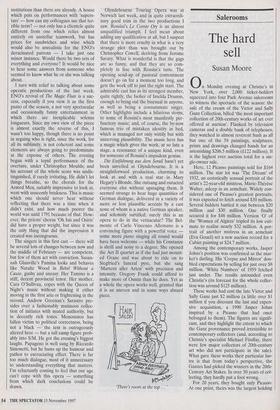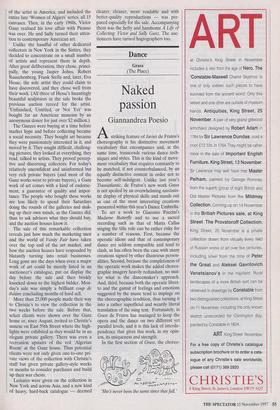Salerooms
The hard sell
Susan Moore
Here, 12 Picasso paintings sold for $164 million. The star lot was The Dream' of 1932, an ecstatically sensual portrait of the artist's 22-year-old mistress, Marie-Therese Walter, asleep in an armchair. Widely con- sidered one of Picasso's greatest portraits, it was expected to fetch around $30 million. Several bidders battled it out between $20 million and $30 million. One finally secured it for $48 million. Version '0' of the 'Women of Algiers' tripled its low esti- mate to realise nearly $32 million. A por- trait of another mistress in an armchair (Eva Gouel) set a new auction record for a Cubist painting at $24.7 million.
Among the contemporary works, Jasper Johns's position was confirmed as the mar- ket's darling. His 'Corpse and Mirror' dou- bled expectations by selling for just over $8 million. 'White Numbers' of 1959 fetched just under. The results astounded even Christie's (its forecast for the whole collec- tion was around $125 million).
These works had cost the late Victor and Sally Ganz just $2 million (a little over $1 million if you discount the last and expen- sive acquisition, a 1990 Jasper Johns inspired by a Picasso that had once belonged to them). The figures are signifi- cant, and they highlight the extent to which the Ganz provenance proved irresistible to contemporary collectors (and, according to Christie's specialist Michael Findlay, there were few major collectors of 20th-century art who did not participate in the sale). What gave these works their particular lus- tre is that from today's perspective, the Ganzes had picked the winners in the 20th- Century Art Stakes. In over 50 years of col- lecting, they hardly put a foot wrong.
For 20 years, they bought only Picasso. At one point, theirs was the largest holding of the artist in America, and included the entire late 'Women of Algiers' series, all 15 canvases. Then, in the early 1960s, Victor Ganz realised his love affair with Picasso was over. He and Sally turned their atten- tion to contemporary American art.
Unlike the handful of other dedicated collectors in New York in the Sixties, they decided to concentrate on a small number of artists and represent them in depth. After great deliberation, they chose, princi- pally, the young Jasper Johns, Robert Rauschenberg, Frank Stella and, later, Eva Hesse, the sole artist they could claim to have discovered, and they chose well from their work. (All three of Hesse's hauntingly beautiful sculptures in the sale broke the previous auction record for the artist. `Unfinished, Untitled, or Not Yet' was bought for an American museum by an anonymous donor for just over $2 million ) The Ganzes were buying at a time before market hype and before collecting became a social necessity. They bought art because they were passionately interested in it, and moved by it. They sought difficult, challeng- ing pictures, they looked at everything, they read, talked to artists. They proved percep- tive and discerning collectors. For today's relatively unconfident and uninformed but very rich private buyers (and most of the Ganz works went to private buyers), a Ganz work of art comes with a kind of endorse- ment, a guarantee of quality and impor- tance. The people who bought these works are less likely to spend their Saturdays doing the rounds of the galleries and mak- ing up their own minds, as the Ganzes did, than to ask advisors what they should buy, and the auction houses know it.
The sale of this remarkable collection reveals just how much the marketing men and the world of Vanity Fair have taken over the top end of the art market, and how the auction houses have responded by blatantly turning into retail businesses. Long gone are the days when even a major work of art could be merely listed in an auctioneer's catalogue, put on display the day before the sale and then briskly knocked down to the highest bidder. Mon- day's sale was simply a brilliant coup de theatre concluding months of hard sell.
More than 25,000 people made their way to Christie's to view the collection in the two weeks before the sale. Before that, select clients were shown over the Ganz home or, since August, invited to Christie's annexe on East 59th Street where the high- lights were exhibited as they would be in an elegant private gallery. There was even a recreation upstairs of the red 'Algerian Room' at the Ganz house. Thus potential clients were not only given one-to-one pri- vate views of the collection with Christie's staff but given private gallery-style weeks or months to consider purchases and build up their war chests.
Lectures were given on the collection in New York and across Asia, and a new kind of heavy, hard-back catalogue — deemed clearer, cleaner, more readable and with better-quality reproductions — was pre- pared especially for the sale. Accompanying them was the hefty and handsome A Life of Collecting:• Victor and Sally Ganz. The auc- tioneers have turned hagiographers too.











































































 Previous page
Previous page